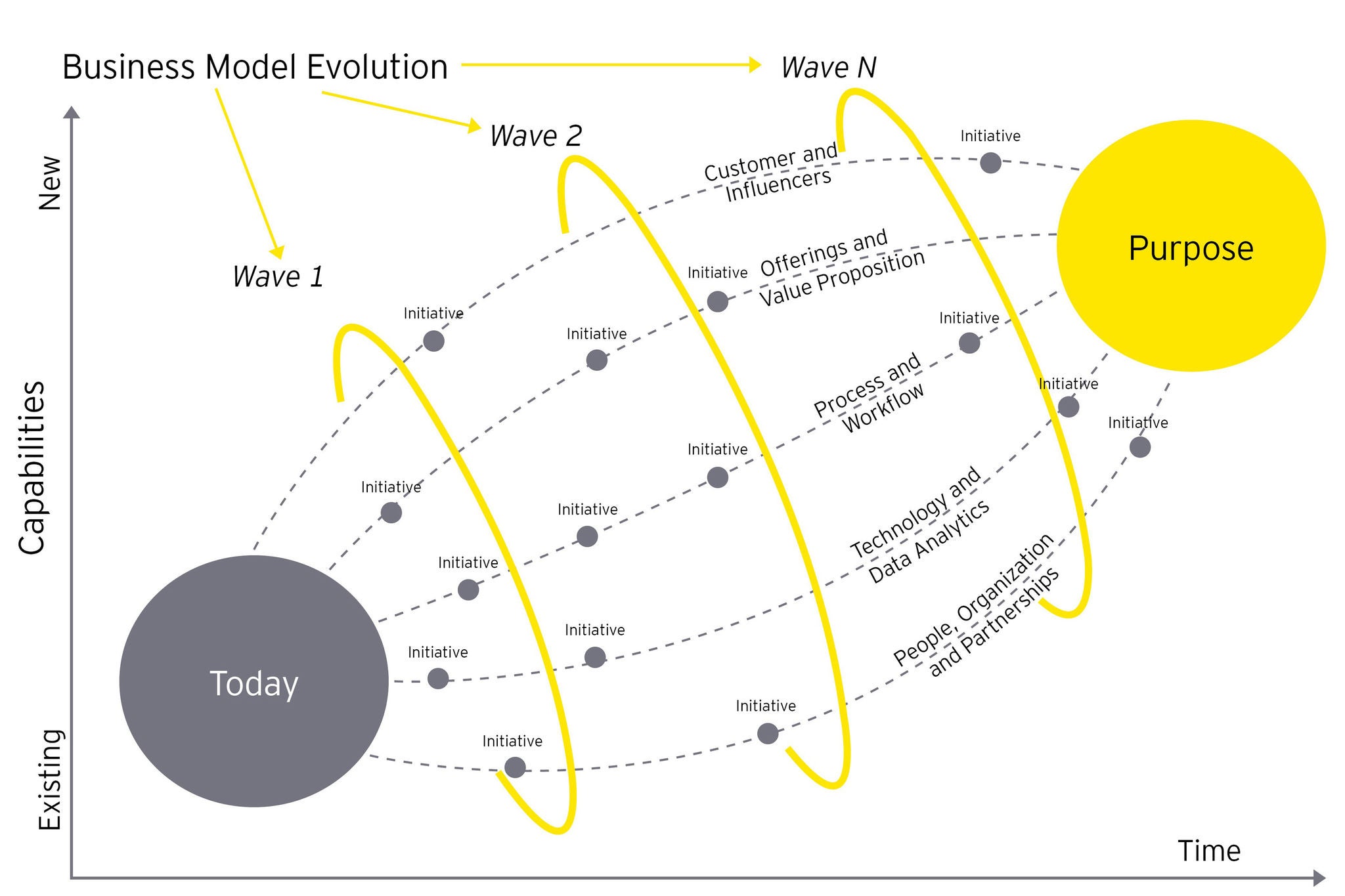EY refers to the global organization, and may refer to one or more, of the member firms of Ernst & Young Global Limited, each of which is a separate legal entity. Ernst & Young Global Limited, a UK company limited by guarantee, does not provide services to clients.
Strategic Roadmap
This future-back framework describes the necessary evolution of an organization’s capabilities to execute strategy and realize purpose. Beginning with a three- to five-year aspirational purpose, it works back to define the process, technology and organizational capabilities required to activate it.
What EY can do for you
The Strategic Roadmap represents a structured, systematic approach to align and prioritize investments across operational initiatives, partnerships and acquisitions. It isolates business model assumptions, and identifies operating model dependencies that create implicit risk for strategy execution and financial results. In this way, EY Strategic Roadmap helps to articulate the actionable, measurable steps to answer the question, ”What is required to execute the strategy?”
Using the Strategic Roadmap, decision-makers can then assign resources and fund investments where they will have the biggest impact in building capability to advance the organization’s strategy and purpose. What’s more, leaders can begin to filter and rationalize their existing portfolio of initiatives and capital investments that are not directly aligned or not appropriately timed to achieve their strategy and purpose.
Ultimately, EY Strategic Roadmap approach helps focus leadership attention on the highest-priority initiatives and actions — including time lines and accountability — to close the gap from purpose to strategy execution.
How EY Strategic Roadmap works
The concept is straightforward, though the diagram may appear complex at first.

Step 1: Frame purpose as the future state
It starts with clear articulation of purpose. [See the yellow circle in the upper right of the diagram.] While many organizations have spent time to define their mission, vision and values, few can fully describe an inspiring and actionable purpose statement. An organization’s purpose articulates the unique benefits and value proposition it delivers to targeted customers and stakeholders. Going beyond strictly internal or financial results, purpose represents what an organization wants to be known for doing, and it aligns and focuses the organization on its most important priorities. Fundamentally, it is an aspirational and motivating statement of intent that is critical to aligning an organization and achieving a strategy.
Step 2: Summarize the current state
Working back from that future, the next step is to describe where the organization is today. [See the gray circle in the lower left of the diagram.]
How would the primary customers and stakeholders describe the organization today? What differentiated assets and capabilities create potential competitive advantages? And how big is the gap to achieving the purpose and executing the strategy?
Step 3: Articulate the vectors of investment
The Strategic Roadmap defines a clear, actionable path forward to close the gap between an organization’s future purpose and its current capabilities. We ask, “What must be true for us to achieve our purpose?” and systematically deconstruct this macro question to assess five vectors or streams of investment and activity:
- Customers and influencers
Who are the target customer segments and geographic markets? How will this evolve over time?
- Offerings and value proposition
What is the value proposition and customer experience? What new innovations will we bring to market over time?
- Processes and workflow
How will we redesign the business processes to deliver the value proposition and enable the desired customer experience?
- Technology and data analytics
How will the technology systems, data and analytics capabilities support the value proposition?
- People, organization and partnerships
What new organizational roles and partnerships will be required to deliver the value proposition?
Asking better questions to activate purpose
Mapped within each of these five vectors are the specific initiatives designed to enable the necessary improvements that evolve the business from what it is today to what it aspires to be.
For example, are the process or technology investments aligned to deliver the desired value proposition to target customers when these products or services are expected to launch? If not, what changes are required in the timing and sequencing of these initiatives? Do gaps exist across these initiatives or capabilities required to deliver and how do we fill them? Should any existing initiatives or investments be deprioritized and/or rationalized because they don’t directly contribute to achieving the purpose and executing the strategy?
In this way, the Strategic Roadmap helps an organization ask better questions to activate its purpose and execute its strategy while delivering on financial and non-financial commitments to stakeholders. These kinds of questions help reveal both the operational capabilities required to realize effective strategy execution and the gaps that create risk.
To mitigate those risks, it is advised that organizations take a holistic view of these business model components. There should be both a horizontal and vertical logic or connection between the initiatives: horizontally, the initiatives should describe growth of the organization’s capabilities on each business model vector over time; equally important is the vertical logic that aligns the initiatives and manages optimal timing of strategic dependencies.
And looking holistically across these vectors reveals the waves of evolution of the business model that will advance the organization in its journey.
Taken together, these waves also describe how the organization will make money over time. By answering the questions “Who is our customer?” and “What is our value proposition?,” we are effectively defining a revenue model. In addressing the “How?” related questions around processes, technology, and people, we are describing the organization’s operating model cost structure and capital investments. As a result, these waves of capability investment provide a foundation for estimating the potential financial impact of an organization achieving its purpose by successfully executing its strategy.
The resulting Strategic Roadmap and portfolio of initiatives are aligned to create mutually reinforcing investments in capability over time. The integration of an organization’s answers to these questions — who, what and how — define its Strategic Roadmap to achieve its why.



